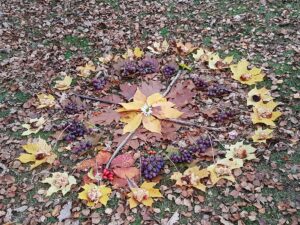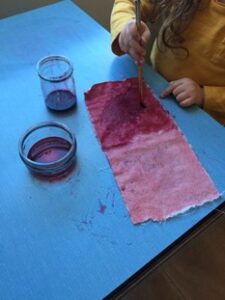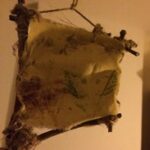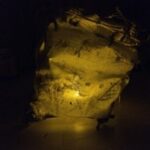Forest School in Ramadan
By Nadine Marroushi – Forest School Training Student
This month is a holy month for Muslims around the world. This week we are celebrating Forest School in Ramadan. The Islamic calendar is based around the lunar cycle and this year it begins on Monday 12th April and will end on 11th May.
It was on a yoga trek on the Nepalese side of the Himalayas a few years ago when I really stopped to take notice of how beautiful our Earth is. The sight of red rhododendrons set against majestic, ice-capped mountains really struck me. At the time, I had been working as a journalist in Egypt where there was a lot of violence. I remember thinking how privileged I was to experience something more peaceful and in harmony with nature. I think those were my first real steps to where I am today.
After journalism I turned to human rights campaigning and then I became a mother – another of life’s turning points. It was through my first child, my daughter, that I learned about forest school and the thought struck me: this is what I want to do. So, I am now training to be a Forest School Leader with Circle of Life Rediscovery and hope that one day I will run my own forest school programme.
“On Earth are signs for those whose faith is certain. And, also, in yourselves. Will you not then see?” The Quran, 51:20-21
 As Forest School Leaders, our role is to help our learners develop a relationship with the natural world, so that they and we can reap many benefits: a more peaceful mental state, an appreciation for the trees, plants, birds, insects, animals, and a natural setting where we can play.
As Forest School Leaders, our role is to help our learners develop a relationship with the natural world, so that they and we can reap many benefits: a more peaceful mental state, an appreciation for the trees, plants, birds, insects, animals, and a natural setting where we can play.
So, what does this month of Ramadan offer for our Forest School practice? Most people know Ramadan as the month in which Muslims around the world fast from Dawn till Dusk. But it is also the month in which the Quran is believed to have been revealed, in which Muslims are encouraged to pray more, read more of the Quran, reflect on its meanings, and be more charitable. It begins when the first crescent of a new moon is sighted, and ends after the full cycle of the moon and a new crescent is sighted again.
 When we’re out in nature, one way I think we can connect Ramadan with our Forest School practice is to use the symbolism of the mandala. It is made with natural objects, such as sticks, leaves, fallen petals to form the circle and two sticks in the middle for the compass.
When we’re out in nature, one way I think we can connect Ramadan with our Forest School practice is to use the symbolism of the mandala. It is made with natural objects, such as sticks, leaves, fallen petals to form the circle and two sticks in the middle for the compass.
During my Forest School training, my teacher Marina Robb gave us a beautiful talk around the mandala. She talked about how the sun rises from the East and this being a symbol for birth, for the early years in our life, for the Spring season. When we reach towards the South, the sun is at its highest point in the day, we move towards the Summer time, and this can also symbolise our teenage years and our twenties when our energies and emotions are high, when our brains become fully developed.
And then we move towards the Autumn, towards the sun setting, the West. This being the part of our lives when we, like the leaves, develop into new shades. And, finally, the sun sets and we reach South, the latter part of our lives, our Elderhood, a phase that in traditional communities is respected not put away.
“We are hugely impacted by nature,” says Marina Robb. “Everyone is on this natural cyclical journey. When you meet people, ask: where are they on this journey.”
The mandala is relevant too, I think, to the daily life of a Muslim. It could be used to explain the monthly cycle of the moon. It could also be used in relation to the five daily prayers, which is tied to the movement of the sun. Fajr, the Dawn prayer, begins with the red horizon in the sky before the sun rises from the East. At the North point, just after the sun passes its peak, it is time for the Dhuhr prayer, when shadow lengths are also at their shortest in the day. Then Asr, the afternoon prayer, when shadow lengths double. This is followed by Maghrib, the sunset prayer. And Ishaa, the night prayer.
“The sun and the moon travel with precision”. (The Quran, 55:5)
This year instead of paper we are using sticks to make our Ramadan lanterns, or fanous Ramadan in Arabic. All over the Muslim world, and particularly in Egypt where the tradition is said to originate, colourful lanterns decorate homes and shop fronts during this month.
To make our lanterns, I used the square lashing technique to make a cuboid structure.
Then, we used natural paint to dye calico. For yellow, we used turmeric and water. For pink, beetroot juice and for purple blueberry juice.
We then collected flowers and leaves and printed them on calico. Our yellow patch turned out well, because the flora was freshly picked and immediately printed onto the calico with a wooden mallet we made in my forest school training. My daughter and I decided to paint some of the leaves gold and print them on to the purple calico patch because it is such a dark colour. With the pink side, our printing didn’t go as well, because the flora wasn’t freshly picked and so the natural moisture you need for the printing had dried out. Lesson learned.
I then tied the calico onto the lantern with the twine I used for square lashing. At night, we use an LED tea light candle to light it up.
Ramadan Kareem in Arabic, or Generous Ramadan.
Forest School Training in East Sussex
 The next course with Circle of Life Rediscovery takes place in June 2021. Approved by the Forest School Association and Awarded by the Open College Network West Midlands, this Level 3 Certificate provides the knowledge, understanding and skills needed to prepare learners to work as a Forest School Leader.
The next course with Circle of Life Rediscovery takes place in June 2021. Approved by the Forest School Association and Awarded by the Open College Network West Midlands, this Level 3 Certificate provides the knowledge, understanding and skills needed to prepare learners to work as a Forest School Leader.
You can find out all the details and dates of the training on the website.
Circle of Life Rediscovery provides exciting and highly beneficial nature-centred learning and therapeutic experiences for young people, adults, and families in Sussex woodlands, along with innovative continuing professional development for the health, well being and teaching professionals who are supporting them.







